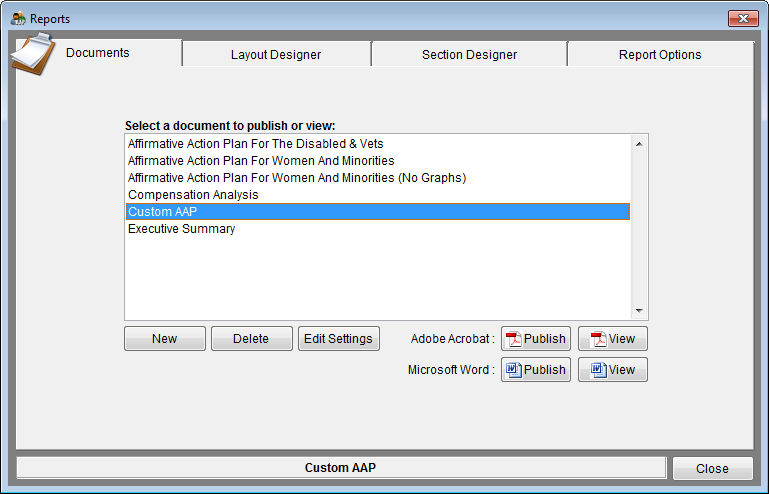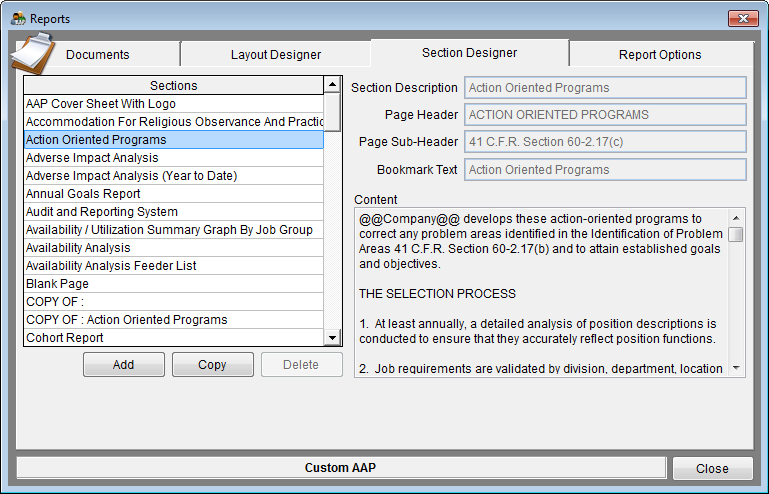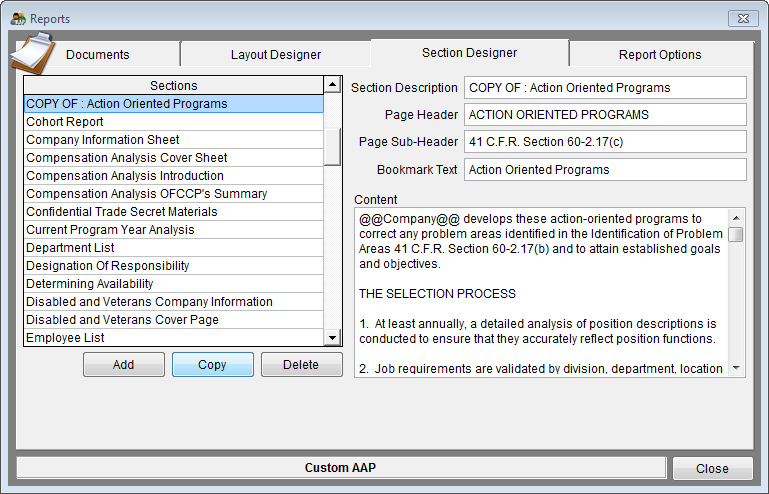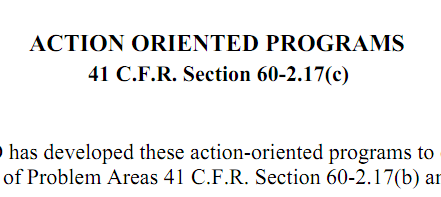Section Designer
If you have not already created an editable document, follow the steps in Create A New Document above before proceeding.
1) Click the Reports icon.
2) Click on the document that you created.
3) Click the Section Designer tab. The list of available sections is shown on the left side.
- a. If you want to make changes to one of the existing sections, click on it in the list, and then click the Copy button. This copies the section you highlighted, and automatically names it COPY OF: _____________.
- b. If you want to create a new section, click the Add button.
4) Edit the section text using the Text Entry Field descriptions below as a guide.
Text Entry Fields:
The sections below can be changed in the Section Designer tab by typing new or overwriting the text in the boxes beside them. While you are editing the fields, keep in mind the following:
• Some of the document sections listed on the left side of the Section Designer tab cannot be copied or edited. • There are no editing functions available in the Section Designer tool, such as bold, indent, etc. If you plan extensive editing and wish to use word processing functions, we suggest that you publish your final AAP to Word rather than PDF format. • Text entered into the fields is saved automatically when the Close button is pressed.
Section Description: The text in the Section Description field serves to distinguish the section from others in the Sections list. This title does not appear on published reports.
Page Header: The text entered into the Page Header field appears in bold text at the top of the section’s page in the narrative of the AAP. This header is represented by the words “Action Oriented Programs” in the example below.
Page Sub-Header: The text entered into the Page Sub-Header field appears in bold directly under the page header. This header is represented by the words “41 C.F.R. Section 60-2.17(c)” in the example below.
Bookmark Text: Text entered into the Bookmark Text field is the name that is given to the section’s bookmark in the published PDF document. An example is shown below.
Content: This text appears in the main body of the published section. The text is standard and cannot be formatted to be bold, italic, etc. Items that appear in the General Info & Narrative Info tabs of the Plan Information window can be inserted automatically into the narrative by using “@@”symbols as shown in the Content box of the image below.
To insert fields into the Content text, type them exactly as they appear in the list below. The @@Company@@ entry pulls text directly from the Plan Name field of the Plan Information window’s General Info tab. The @@User_Name@@ entry pulls from the User tab of the Utilities menu’s Options window. The @@Date@@ entry inserts the current date when the document is published. All others listed below are pulled directly from the General Info tab of the Plan Information window.
@@Company@@
@@User_Name@@
@@Date@@
@@Company_Dunn__Bradstreet_@@
@@Employer_ID_@@
@@Company_EEO1@@
@@EEO_Contact@@
@@EEO_Company@@
@@Address_1@@
@@City@@
@@State@@
@@Zip@@
@@EEO_Contact_Phone_@@
@@Parent_Company@@
@@Parent_Dunn__Bradstreet_@@
@@Parent_EIN@@
@@Parent_EEO1@@
@@Executive_Officer@@
@@Executive_Officer_Title@@
@@PlanStartDate@@
@@PlanEndDate@@
After you create custom sections, insert them into the layout of your document by using the Layout Designer tool.
Proceed to Layout Designer.
© Copyright Yocom & McKee, Inc.




